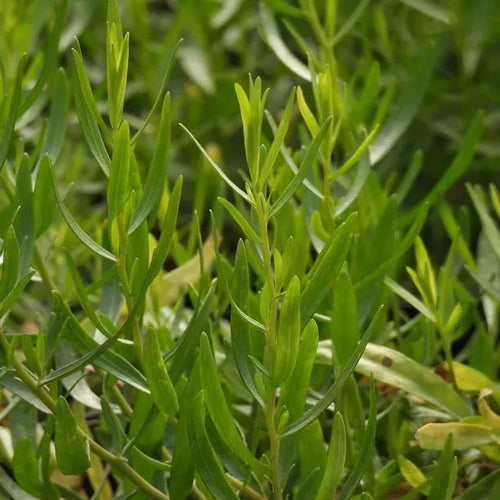French Tarragon Plants
French Tarragon, also known as Estragon or the Dragon plant, is the Aston Martin of herbs: it needs a little fine-tuning to run, but its flavour and impact are second to none. It's quite a large herb with dark green, narrow leaves that are long and smooth. The strong, slightly aniseedy flavour plays many roles in French cooking but is most famously used in Bearnaise sauce. In summer, tiny insignificant yellow flowerheads appear in little sprays, but the seed rarely ripens unless it's super hot. The leaves definitely taste better before it flowers, so it's worth trimming the herb once you see flowers forming. The fantastic flavour of French tarragon begins to diminish after about three years, so you will need to take cuttings or just buy some more plants at that point.
Looking after the French Tarragon
Like many things French, this tarragon can be a little temperamental because it doesn't like having its roots wet, and it doesn't like frost. So an obvious solution is to keep it in pots using a bark and grit mix of compost. Make the pot big enough to hold the runners that it'll inevitably produce. Water in the daytime and sparingly but regularly. Do not feed it because the leaves become too succulent and then tasteless. In winter, when the plant is dormant, do not water it at all, but keep it somewhere frost-free. If you grow tarragon in the garden, ensure that it's somewhere that doesn't suffer from winter wet soil, otherwise it'll die. Like sage and thyme, it requires a sunny site to give of its best. Harvest the leaves in early summer, ideally before the plant has flowered, and pop a sprig or two into a bottle of white wine vinegar to use for sauces and dressings. Chop the fresh herb into anything chicken-y, fishy or eggy for a real hit of flavour.
Features
- Height: 90 cm
- Spread: 45 cm
- Colour: dark green
- Flowers: tiny yellow
- Uses: culinary
- Taste: strong
- Harvest: summer
- Storage: freeze
- Spacing: 60 cm
- Life: half-hardy perennial
History & Trivia
Apart from sounding like one of The Three Musketeers, beware impostors. French Tarragon has a far superior flavour to Russian tarragon, but the latter is often passed off as the former. Russian tarragon is taller, coarser, and less tasty, but it'll survive frosts.
Popular in the Tudor court, Henry the Eighth is said to have cited Catherine of Aragon's reckless use of tarragon as one of his reasons for wishing to divorce her.
It's one of les fines herbes, and thus a cornerstone of French cuisine (the others are parsley, chives, and chervil).

 Secure, One-Tap Checkout
Secure, One-Tap Checkout
 Hand Picked, Delivered to Your Door!
Hand Picked, Delivered to Your Door! 1 Year Bareroot Guarantee
1 Year Bareroot Guarantee